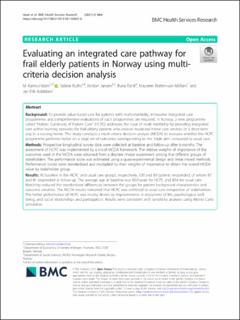| dc.contributor.author | Islam, Kamrul | |
| dc.contributor.author | Ruths, Sabine | |
| dc.contributor.author | Jansen, Kristian | |
| dc.contributor.author | Falck, Runa | |
| dc.contributor.author | Rutten-van Mölken, Maureen | |
| dc.contributor.author | Askildsen, Jan Erik | |
| dc.date.accessioned | 2022-01-18T09:05:43Z | |
| dc.date.available | 2022-01-18T09:05:43Z | |
| dc.date.created | 2021-08-31T14:43:31Z | |
| dc.date.issued | 2021 | |
| dc.identifier.issn | 1472-6963 | |
| dc.identifier.uri | https://hdl.handle.net/11250/2837816 | |
| dc.description.abstract | Background To provide value-based care for patients with multi-morbidity, innovative integrated care programmes and comprehensive evaluations of such programmes are required. In Norway, a new programme called “Holistic Continuity of Patient Care” (HCPC) addresses the issue of multi-morbidity by providing integrated care within learning networks for frail elderly patients who receive municipal home care services or a short-term stay in a nursing home. This study conducts a multi-criteria decision analysis (MCDA) to evaluate whether the HCPC programme performs better on a large set of outcomes corresponding to the ‘triple aim’ compared to usual care. Methods Prospective longitudinal survey data were collected at baseline and follow-up after 6-months. The assessment of HCPC was implemented by a novel MCDA framework. The relative weights of importance of the outcomes used in the MCDA were obtained from a discrete choice experiment among five different groups of stakeholders. The performance score was estimated using a quasi-experimental design and linear mixed methods. Performance scores were standardized and multiplied by their weights of importance to obtain the overall MCDA value by stakeholder group. Results At baseline in the HCPC and usual care groups, respectively, 120 and 89 patients responded, of whom 87 and 41 responded at follow-up. The average age at baseline was 80.0 years for HCPC and 83.6 for usual care. Matching reduced the standardized differences between the groups for patient background characteristics and outcome variables. The MCDA results indicated that HCPC was preferred to usual care irrespective of stakeholders. The better performance of HCPC was mostly driven by improvements in enjoyment of life, psychological well-being, and social relationships and participation. Results were consistent with sensitivity analyses using Monte Carlo simulation. Conclusion Frail elderly with multi-morbidity represent complex health problems at large costs for society in terms of health- and social care. This study is a novel contribution to assessing and understanding HCPC programme performance respecting the multi-dimensionality of desired outcomes. Integrated care programmes like HCPC may improve well-being of patients, be cost-saving, and contribute to the pursuit of evidence based gradual reforms in the care of frail elderly. | |
| dc.language.iso | eng | en_US |
| dc.rights | Navngivelse 4.0 Internasjonal | * |
| dc.rights.uri | http://creativecommons.org/licenses/by/4.0/deed.no | * |
| dc.title | Evaluating an integrated care pathway for frail elderly patients in Norway using multi-criteria decision analysis | en_US |
| dc.type | Peer reviewed | en_US |
| dc.type | Journal article | en_US |
| dc.rights.holder | © 2021, the authors | |
| dc.description.version | publishedVersion | |
| cristin.ispublished | true | |
| cristin.fulltext | original | |
| cristin.qualitycode | 2 | |
| dc.identifier.doi | 10.1186/s12913-021-06805-6 | |
| dc.identifier.cristin | 1930148 | |
| dc.source.journal | BMC Health Services Research | en_US |
| dc.source.volume | 21 | en_US |
| dc.relation.project | EU – Horisont Europa (EC/HEU): 634288 | |

